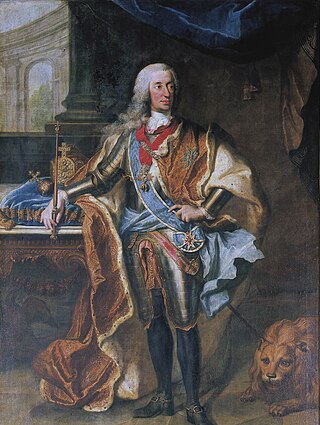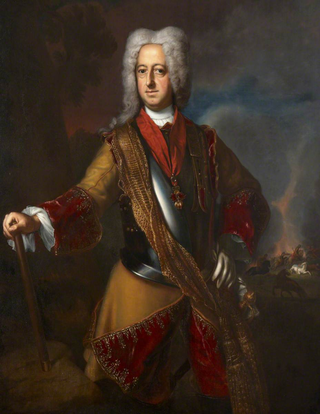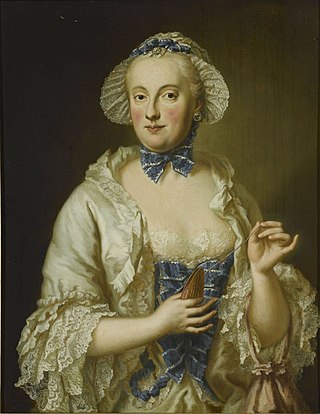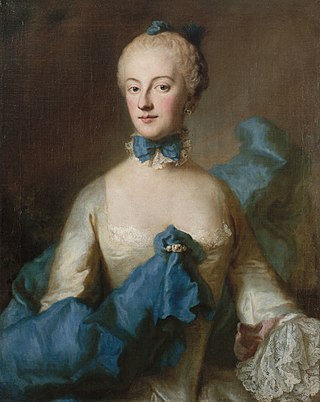
The House of Wittelsbach is a former Bavarian dynasty, with branches that have ruled over territories including the Electorate of Bavaria, the Electoral Palatinate, the Electorate of Cologne, Holland, Zeeland, Sweden, Denmark, Norway, Hungary, Bohemia, and Greece. Their ancestral lands of Bavaria and the Palatinate were prince-electorates, and the family had three of its members elected emperors and kings of the Holy Roman Empire. They ruled over the Kingdom of Bavaria which was created in 1805 and continued to exist until 1918.

Charles VII was Prince-Elector of Bavaria from 26 February 1726 and Holy Roman Emperor from 24 January 1742 to his death. He was also King of Bohemia from 1741 to 1743. Charles was a member of the House of Wittelsbach, and his reign as Holy Roman Emperor thus marked the end of three centuries of uninterrupted Habsburg imperial rule, although he was related to the Habsburgs by both blood and marriage.

Maximilian II, also known as Max Emanuel or Maximilian Emanuel, was a Wittelsbach ruler of Bavaria and a prince-elector of the Holy Roman Empire. He was also the last governor of the Spanish Netherlands and Duke of Luxembourg. An able soldier, his ambition led to conflicts that limited his ultimate dynastic achievements.

Maximilian I, occasionally called the Great, a member of the House of Wittelsbach, ruled as Duke of Bavaria from 1597. His reign was marked by the Thirty Years' War during which he obtained the title of a prince-elector of the Holy Roman Empire at the 1623 Diet of Regensburg.

The War of the Bavarian Succession was a dispute between the Austrian Habsburg monarchy and an alliance of Saxony and Prussia over succession to the Electorate of Bavaria after the extinction of the Bavarian branch of the House of Wittelsbach. The Habsburgs sought to acquire Bavaria, and the alliance opposed them, favoring another branch of the Wittelsbachs. Both sides mobilized large armies, but the only fighting in the war was a few minor skirmishes. However, thousands of soldiers died from disease and starvation, earning the conflict the name Kartoffelkrieg in Prussia and Saxony; in Habsburg Austria, it was sometimes called the Zwetschgenrummel.

Charles Theodore was a German nobleman of the Sulzbach branch of the House of Wittelsbach. He became Count Palatine of Sulzbach at the age of six following the death of his father Johann Christian in 1733. With the death of his cousin, Charles III Philip, he became Prince-elector and Count Palatine of the Rhine in 1742, being eighteen. In his fifties, he became Prince-Elector of Bavaria at the death of another cousin, Maximilian III Joseph, in 1777.

Ferdinand Maria was a Wittelsbach ruler of Bavaria and a prince-elector of the Holy Roman Empire from 1651 to 1679. The Elector modernized the army and introduced Bavaria's first government code. Besides encouraging agriculture and industry, he also improved building and restoration works on churches and monasteries since the damage caused during the Thirty Years' War.

The Nymphenburg Palace is a Baroque palace situated in Munich's western district Neuhausen-Nymphenburg, in Bavaria, southern Germany. The Nymphenburg served as the main summer residence for the former rulers of Bavaria of the House of Wittelsbach. Combined with the adjacent Nymphenburg Palace Park it constitutes one of the premier royal palaces of Europe. Its frontal width of 632 m (2,073 ft) even surpasses Versailles.

The Peace of Füssen was a peace treaty signed at Füssen, between the Electorate of Bavaria and Habsburg Austria. Signed on 22 April 1745, it ended the participation of Bavaria on the French side in the War of the Austrian Succession.

The Residenz in central Munich is the former royal palace of the Wittelsbach monarchs of Bavaria. The Residenz is the largest city palace in Germany and is today open to visitors for its architecture, room decorations, and displays from the former royal collections.
The Treaty of Teschen was signed on 13 May 1779 in Teschen, then in Austrian Silesia, between the Austrian Habsburg monarchy and the Kingdom of Prussia, which officially ended the War of the Bavarian Succession.
François de Cuvilliés, sometimes referred to as the Elder, was a Spanish Netherlands-born Bavarian decorative designer and architect. He was instrumental in bringing the Rococo style to the Wittelsbach court at Munich and to Central Europe in general.

Maria Amalia of Austria was Holy Roman empress, queen of Bohemia, and electress of Bavaria among many other titles as the spouse of Emperor Charles VII. By birth, she was an archduchess of Austria as the daughter of Emperor Joseph I. One of her children was Maximilian III Joseph, Elector of Bavaria.

The Electorate of Bavaria was a quasi-independent hereditary electorate of the Holy Roman Empire from 1623 to 1806, when it was succeeded by the Kingdom of Bavaria.

Maria Anna Sophia of Saxony was a daughter of King Augustus III of Poland and his wife Maria Josepha of Austria who became Electress of Bavaria by marriage to Maximilian III Joseph, Elector of Bavaria.

Charles II August Christian was Duke of Zweibrücken from 1775 to 1795. A member of the Palatine House of Zweibrücken-Birkenfeld, a branch of the House of Wittelsbach, he was the elder brother of the first King of Bavaria, Maximilian I, and of Queen Amalia of Saxony.

Archduchess Auguste Ferdinande of Austria was the only daughter of Leopold II, Grand Duke of Tuscany, and his first wife, Maria Anna of Saxony, to survive to adulthood. She married Prince Luitpold of Bavaria, who later became the Prince Regent of Bavaria after her death.

Maria Anna Josepha of Bavaria was a Duchess of Bavaria by birth and Margravine of Baden-Baden by marriage. She was nicknamed the savior of Bavaria. She is also known as Maria Josepha and is sometimes styled as a princess of Bavaria.
The imperial election of 1745 was an imperial election held to select the emperor of the Holy Roman Empire. It took place in Frankfurt on September 13.
The imperial election of 1790 was an imperial election held to select the emperor of the Holy Roman Empire. It took place in Frankfurt on 30 September.





















